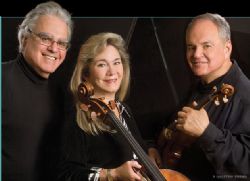|
Symphony
FROM THE NEW WORLD TO THE OLD WORLD
by Peter Lert
Saturday, June 14, 2025
Chamber
MC2 DUO RECITAL CLOSES 222'S SEASON
by Terry McNeill
Saturday, June 14, 2025
Choral and Vocal
CANTIAMO SONOMA'S LUSCIOUS A CAPELLA SINGING IN SEASON ENDING CONCERT
by Pamela Hicks Gailey
Sunday, June 8, 2025
Symphony
SRS SEASON ENDS WITH RESOUNDING TA-TA-TA-BANG
by Terry McNeill
Sunday, June 1, 2025
Symphony
YOUTHFUL VIRTUOSITY ON DISPLAY AT USO'S MAY CONCERTS
by Peter Lert
Saturday, May 17, 2025
Symphony
MYSTICAL PLANETS AND LIVELY GERSHWIN ORTIZ AT FINAL SRS CONCERT
by Peter Lert
Sunday, May 4, 2025
Symphony
VSO'S CONCERT MUSIC OF TIME, MUSIC OF PLACE
by Peter Lert
Sunday, April 27, 2025
VOCAL ELEGANCE AND FIRE AT THE 222'S RECITAL APRIL 26
by Pamela Hicks Gailey
Saturday, April 26, 2025
CANTIAMO SONOMA SINGS AN INSPIRED GOOD FRIDAY MOZART REQUIEM CONCERT
by Pamela Hicks Gailey
Friday, April 18, 2025
DRAMATIC SHOSTAKOVICH SYMPHONY CLOSES PHILHARMONIC'S 25TH SEASON
by Terry McNeill
Sunday, April 13, 2025
|
 |
 Kalichstein-Laredo-Robinson Trio |
ENSEMBLE PERFECTION IN KLR TRIO'S 40TH ANNIVERSARY CONCERT
by Terry McNeill
Sunday, January 29, 2017
Longevity has its place in classical music. Composers and especially conductors live a long time, and venerable piano trios can linger for years. One can recall the great Cortot-Thibaud-Casals staying on the international scene for decades, and more recently Stern-Istomin-Rose, Oistrakh-Oborin-Knushevitsky and the Beaux Arts.
A Weill Hall audience of 600 welcomed Jan. 29 the Kalichstein-Laredo-Robinson Trio on their 40th Anniversary tour, and they began quickly with Beethoven’s “Gassenhauer” Trio in B-Flat Major, Op. 11. Here the smooth ensemble and deft pacing that would be heard all evening were immediately telling. The heart of the 1797 work came with Ms. Robinson’s lovely cello introduction in the adagio of a simple, almost cutesy theme, that in Beethoven’s hands becomes complex and convincing. The changes of texture and tempos were dramatic, but always in proportion. The KLR interpretations have admirable balance and continuity.
In the concluding allegretto the pianist Mr. Kalichstein had the biggest part, and he shaped the phrases with changes of touch and attention to pedaling over bar lines. One can’t forget that Beethoven was a virtuoso pianist, and in these variations the composer took a theme bordering on the banal (as he did in the Diabelli and Op. 34 Prometheus Variations) and turned it into precious metal.
Certain iconic works, however old, don’t seem to lose their shock value, with two examples being Stravinsky’s “Rite of Spring” and Bartok’s Piano Sonata from 1926. Shostakovich’s Trio No. 2 (Op. 67), written in 1944, is one of these. Beginning with extended high register cello harmonics that come out of the ether, the subsequent entrance of the piano immediately confirmed Shostakovich as the author. All memories of the Beethoven were erased. The dissonant themes cried out painfully through violinist Jaime Laredo’s silvery though not overly powerful sound. Mr. Laredo’s skilled spiccato bow danced through the scherzo where the music recalled the Op. 57 Quintet written fours earlier.
Mr. Kalichstein’s majestic piano chords that opened the largo gave a feeling of inexorable sadness and gloom, intensified by rich cello vibrato and two repeated ending chords. The music, sarcastic and somber as it was, faded into a mist. Writing for the cello here presaged the 1959 Shostakovich Cello Concerto.
Thrusting and jabbing phrases characterized the playing of the finale with lots of intense bass chords in the piano. The return of the first-movement’s theme led to a potent march played forcefully by Mr. Laredo and Ms. Robinson, and finally an almost inaudible chord.
Following intermission Brahms’ early B Major Trio, Op. 8, was played. The critical entrance of the violin after the opening beguiling piano-cello statement was perfectly on pitch, and Mr. Laredo’s high register featured a sweet but never a thick sonority. He is a master at subtle small crescendos and diminuendos, many at low volume. The last of the many thematic statements grew to a sculpted and needed ritard just before the allegro con brio’s end.
Spicy piano flourishes and spiccato cello bowing highlighted the scherzo, and the lovely second theme was played in violin and cello unisons. Mr. Laredo’s string harmonic ended the movement. Mr. Kalichstein played elegant phrases in the adagio with echoes of the slow movements of the much later Brahms’ C Minor Piano Quartet, and did something rarely heard – he played solo chords selectively in the right hand a tiny bit ahead of the left-hand chords. It was a fetching effect.
Surging romanticism came to the fore in the finale, with the passion level up. At times Mr. Kalichstein’s sound covered that of his partners, not surprising in a composition of such ardor. He took the bottom octave B chord at the end with a loud swack.
In response to continued applause Mr. Laredo announced an encore, “Summertime” from Gershwin’s opera “Porgy and Bess,” arranged by the film and pop composer Andy Stein. The Trio’s performance was laced with still summer heat, lazy with cut notes and little string slides. The audience loved it.
Nicki Bell contributed to this review.
|
